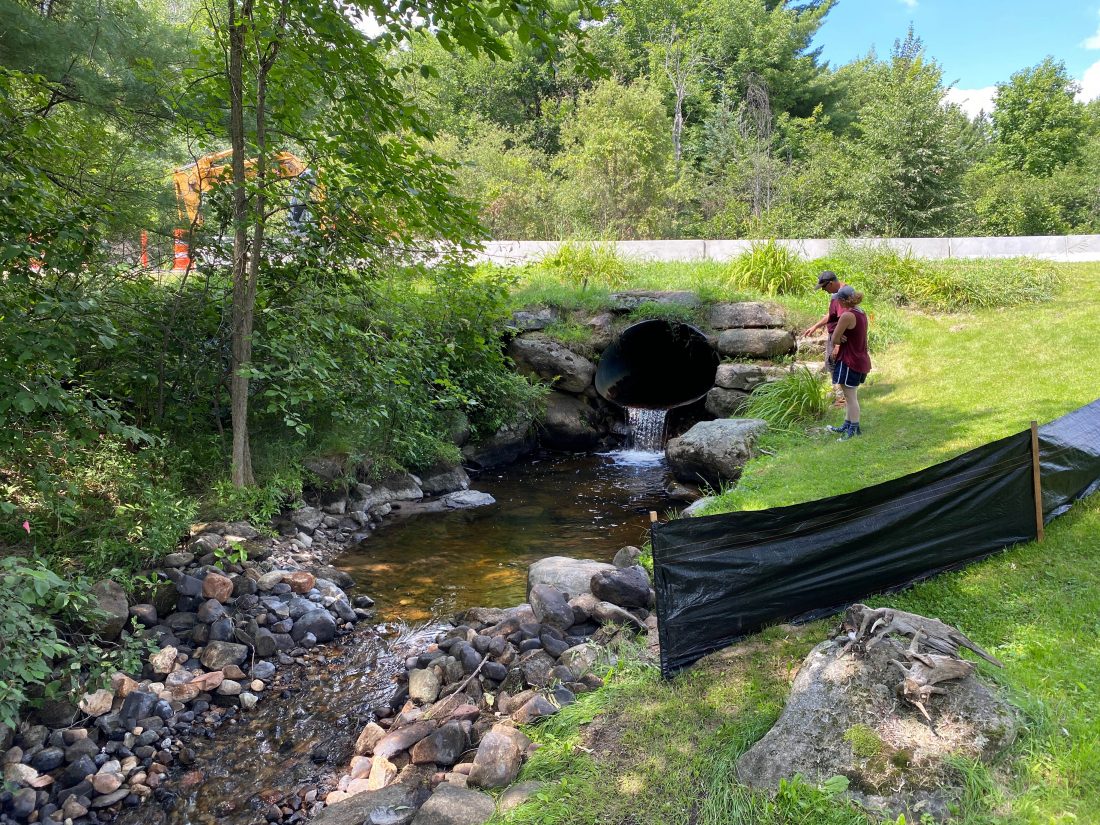Ausable River Association, Nature Conservancy expand culvert initiative
- The AuSable Drive culvert is seen after replacement. (Provided photo — Nature Conservancy, Adirondack Chapter)
- The AuSable Drive culvert is seen during replacement. (Photo provided)
- The AuSable Drive culvert is seen before replacement. (Provided photo — AuSable River Association)

The AuSable Drive culvert is seen after replacement. (Provided photo — Nature Conservancy, Adirondack Chapter)
JAY — The Ausable River Association and The Nature Conservancy’s Adirondack Chapter, in partnership with the town of Jay and U.S. Fish and Wildlife Service, have right-sized two flood vulnerable and ecologically significant culverts in Jay. Work is complete on the Jay Mountain Road and Ausable Drive culvert projects. The new culverts will reduce flood risk and the town’s road maintenance costs and restore aquatic habitat connectivity.
The old culverts on Jay Mountain Road and Ausable Drive prevented a key habitat connection from the Ausable River to stream headwaters, which challenges essential coldwater fish species, such as brook trout. Ausable Drive is a main thoroughfare to Ausable Acres, a community of about 175 homes. It is the only road connecting this community to Jay and Wilmington. While there is an alternate route through the hamlet of Ausable Forks, first responders from Jay and Wilmington rely on Ausable Drive for timely emergency response.
As a result, AsRA and the Conservancy, with oversight from the Service, worked with local contractor Zielinski’s Inc. and the town of Jay to install two bottomless aluminum arch culverts. Both are designed to accommodate a 100-year flood flow at 80% of their capacity. The streams running through each culvert were restored to their natural stream conditions, improving water quality by reducing erosion impacts and preventing sediment from accumulating upstream.
Over 50% of the road-stream crossings in Essex County are estimated to be vulnerable to flooding. The Nature Conservancy, AsRA and project partners including Essex County, the Service, local transportation departments and other Adirondack stakeholders began working to identify priority culvert replacements in the months prior to Tropical Storm Irene in 2011. Local municipal leaders, the Conservancy and AsRA engaged in a prioritization process to identify vulnerable culverts that also restrict aquatic connectivity in ecologically significant areas. A pilot began in 2014 with two retrofit projects in Black Brook. Since then, a total of 10 culverts have been replaced or retrofitted, reconnecting over 100 miles of stream.
“The two new culverts in Jay build on work that began nine years ago when we collaborated with partners to identify and prioritize vulnerable culverts across the Adirondacks. Right-sizing culverts is crucial to reduce flood risks in the face of climate change and to improve fish habitat, allowing them to swim safely up and downstream,” Michelle Brown, senior conservation scientist at The Nature Conservancy, said in a statement.

The AuSable Drive culvert is seen during replacement. (Photo provided)
“Working with our partners we’ve developed an effective model for replacing undersized culverts,” Ausable River Association Executive Director Kelley Tucker said in a statement. “By creating an intersection between a stream and a road that preserves the integrity of the stream, we reduce maintenance, keep property safe, and keep roads open in storms.”
The Ausable River Association helps communities protect their streams and lakes. For more information, visit www.ausableriver.org.
The Nature Conservancy is a global conservation organization dedicated to conserving the lands and waters on which all life depends and has been operating in the Adirondacks since 1971. To learn more, visit www.nature.org.

The AuSable Drive culvert is seen before replacement. (Provided photo — AuSable River Association)







